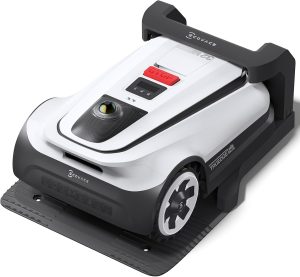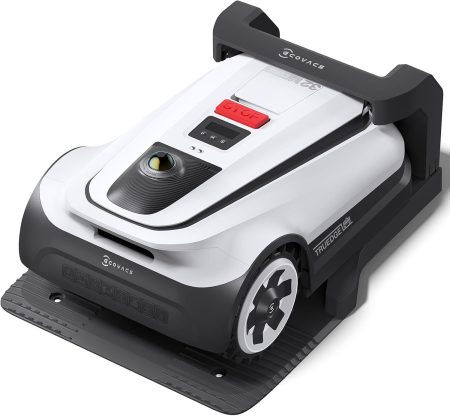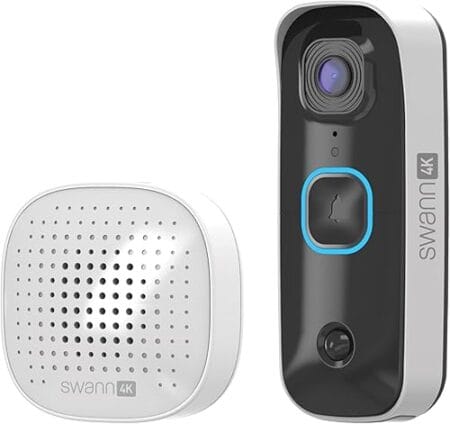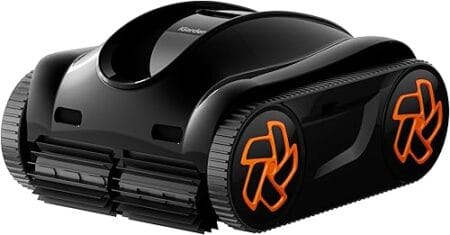The most costly device in its size class is the Aurzen ZIP Tri-Fold Portable Pocket Projector, which retails for $399.99. This makes it more than twice as expensive as our Editors’ Choice for a pocket-size projector, the Kodak Luma 75, but it’s also significantly more powerful because of wifi connections, a brighter image, and other features. The Luma 75 continues to be our top budget choice despite the price difference. But thanks to its robust feature set, the Aurzen ZIP is now our Editors’ Choice winner for a high-end portable projector.
Design
As the name suggests, one of the most remarkable aspects of the ZIP Tri-Fold projector is its ability to fold into a small, pocket-sized 1-by-3.3-by-3.1-inch near-square, which is made possible by the hinges holding its three portions together. (Interesting fact: the folded shape is known as a cuboid.) When unfolded, it forms a Z shape when viewed from the left side, pointing straight ahead to project on a vertical surface. The top component can be rotated up or down to point at whatever you’re using as a screen, while the bottom piece acts as a base and the center piece as a stand.
(The image is squared off for you by auto keystone correction.) It is only 9.9 ounces in weight, which is roughly 2 ounces heavier than my Samsung Galaxy S25.
Starting in the cuboid position, you may either turn the unit over so that the top part hangs straight down over the edge of a table to project on the floor, or you can simply pivot the top section to point straight up to project on the ceiling. When you turn it on its side, it will automatically rotate the image to the correct position and broadcast a TikTok video or other vertical material in portrait mode. Additionally, it’s the first autofocus pocket projector that we’ve seen.
Battery Life and Connectivity
The battery lasts 90 minutes in Eco mode, which is reasonable for a pocket projector but a bit short for, say, watching a movie, according to Aurzen’s rating. Additionally, keep in mind that if the battery is dead, you cannot use the projector with a 5-watt USB connector or phone charger to charge the ZIP. Aurzen suggests a 24-watt charger for extended usage, which enables you to charge and use the ZIP simultaneously. You might wish to order one when you purchase the projector if you don’t already have one.
In my experiments, it was nearly as simple to connect the ZIP wirelessly to my iPad, Windows PC, and Android phone as it was to use wires. Upon activating the ZIP, a picture with concise directions for connecting from Windows, iOS, macOS, and Android devices—including the ID to search for during the connection—is projected. For instance, I just selected the ZIP code, enabled Smart View, and made sure Wi-Fi was switched on for my Samsung phone. Although they were different, the procedures for iOS AirPlay and Windows were equally simple.
Out of the box, the ZIP cannot connect to HDMI devices such as game consoles or Blu-ray players. However, that feature can be added with Aurzen’s CastPlay HDMI Dongle, which costs an additional $99.99. I had some trouble connecting it wirelessly to the ZIP in my tests, but it was mainly because the dongle’s instructions and even an online FAQ didn’t fully explain the setup procedures. According to Aurzen, the documentation will be updated, and a setup video will be added to the website.
Performance
No one anticipates superior brightness or image quality from a pocket-sized projector. However, the Aurzen ZIP performs adequately on both metrics in that regard.
The aforementioned soft focus effect somewhat detracts from fine detail, which was particularly noticeable when attempting to read emails and text presentations with tiny characters. Nevertheless, the ZIP makes up for that by having a greater resolution than its rivals. For instance, the Luma 75 has a resolution of 640 by 360 pixels. Additionally helpful is the ZIP’s autofocus feature, which makes it simple to achieve the ideal focus. The combination compares well with comparable pocket models, but it lacks the crispness that a 720p projector should provide.
In addition, by most people’s standards, the ZIP’s color fidelity for business presentations was generally sufficient for most uses. One picture has rather green skin tones. But the reason that picture is in our test suite is that it tends to show even the smallest green bias. All things considered, I would say that the ZIP file is readily appropriate for presentations, including nearly all that contain images. It can also be used just to display pictures.

Aurzen ZIP Tri-Fold DLP Truly Mini Projector, Pocket Size, Zero-Lag Focus, One-Click Screen Mirroring, Full-Screen Mode, Type-C Fast Charging,
Colors in SDR movies and videos were a little green-shifted and desaturated, but they were within the acceptable range for most people, especially considering the small size of the projector. Even in the darkest settings in our test suite, I was still able to discern what was happening despite the apparent loss of shadow detail. HDR is not supported by the ZIP.
Verdict
Despite being the most stunning portable projector we’ve seen, the Aurzen ZIP is also the priciest. Make sure to check out the less costly Kodak Luma 75 and the AAXA LED Pico+ if you’re on a tight budget. Although they both have the same brightness rating, our tests show that the Luma 75 is brighter. (The ZIP is smarter than both.) However, of the two, only the AAXA LED Pico+ can connect via Wi-Fi Direct.
Consider the Anker Nebula Capsule Air, one of our best choices for a small projector, if the ZIP’s pricing is within your means but you don’t really need its tiny dimensions. It weighs barely 1.2 pounds and is roughly the size of a Coke can. It has built-in streaming with Google TV, supports HDR10, and is brighter than the ZIP.
However, the Aurzen ZIP Tri-Fold is the clear choice if a pocket-sized design is a crucial consideration. It receives our Editors’ Choice award for a high-end portable projector because it easily outperforms its rivals, both literally and figuratively.






